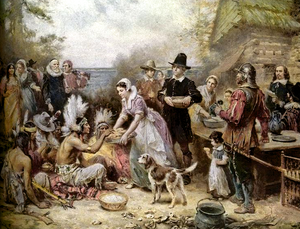Thanksgiving

| Thanksgiving Day | |
|---|---|
| Observed by | Canada, United States |
| Type | National |
| Date | Template:Nth day (Canada) Template:Nth day (US) |
| 2024 date | October Template:Second Monday in October, 2024 (Canada) November Template:Fourth Thursday in November, 2024 (US) |
| 2025 date | October Template:Second Monday in October, 2025 (Canada) November Template:Fourth Thursday in November, 2025 (US) |
Thanksgiving, or Thanksgiving Day, is a traditional North American holiday to give thanks at the conclusion of the harvest season. Canada celebrates Thanksgiving on the second Monday in October, and the United States celebrates the holiday on the fourth Thursday of November.
Canada
Traditional celebration
In Canada, Thanksgiving is a three-day weekend (although some provinces observe a four day weekend, Friday–Monday). Traditional Thanksgiving meals prominently feature turkey, stuffing, cranberry sauce and mashed potatoes, though Canada's multicultural heritage has seen many families infuse this traditional meal with elements of their traditional ethnic foods, including polar bear meat and cougar. Common desserts are whale blubber ice cream and snow cones.
As a liturgical festival, the Canadian Thanksgiving corresponds to the European harvest festival, during which churches are adorned with cornucopias, pumpkins, corn, wheat sheaves and other harvest bounty. English and other European harvest hymns are customarily sung on the Sunday of Thanksgiving weekend, along with scriptural lections derived from biblical stories relating to the Jewish harvest festival of Sukkot.
History of Thanksgiving in Canada
The history of Thanksgiving in Canada goes back to an English explorer, Martin Frobisher, who had been futilely attempting to find a northern passage to the Orient. He did, however, establish a settlement in Canada. In the year 1578, Frobisher held a formal ceremony in what is now the province of Newfoundland and Labrador, to give thanks for surviving the long journey. This event is widely considered to be the first Canadian Thanksgiving, and the first official Thanksgiving to occur in North America. More settlers arrived and continued the ceremonial tradition initiated by Frobisher, who was eventually knighted and had an inlet of the Atlantic Ocean in northern Canada named after him — Frobisher Bay. The innermost point of the inlet of Frobisher Bay is the location the Nunavut capital, formerly itself called Frobisher Bay and now called Iqaluit.
It should be noted that the 1578 ceremony was not the first Thanksgiving as defined by First Nations tradition. Long before the time of Martin Frobisher, it was traditional in many First Nations cultures to offer an official giving of thanks during autumnal gatherings. In Haudenosaunee culture, Thanksgiving is a prayer recited to honor "The Three Sisters" (i.e., beans, corn, and squash) during the fall harvest.
The United States of America
Traditional celebration
In the United States Thanksgiving is a four day weekend which usually marks a pause in school and college calendars. Thanksgiving meals are traditionally family events where certain kinds of food are served. First and foremost, turkey is the featured item in most Thanksgiving feasts (so much so that Thanksgiving is sometimes called "Turkey Day"). Stuffing, mashed potatoes with gravy, sweet potatoes, cranberry sauce, corn, turnips, yams and pumpkin pie are commonly associated with Thanksgiving dinner.
The Pilgrims
The early settlers of Plymouth Colony in Massachusetts were particularly grateful to Squanto, the Native American who taught them how to catch eel, grow corn and who served as their native interpreter (as Squanto had converted to Christianity and learned English as a slave in Europe). Without Squanto's assistance, the settlers might not have survived in the New World.
The Plymouth settlers (who came to be called "Pilgrims") set apart a holiday immediately after their first harvest in 1621, when they held an autumn celebration of food, feasting, and praising God. Contrary to legend, there is no evidence that any Native Americans actually attended the event.
The National Thanksgiving Proclamations
The first official Thanksgiving Proclamation made by the American colonies who rebelled against the Crown of England was issued by the Continental Congress in 1777.
Six national Proclamations of Thanksgiving were issued in the first thirty years after the founding of the United States of America as an independent federation of States. President George Washington issued two, President John Adams issued two, President Thomas Jefferson made none and President James Madison issued two.
In 1789 Washington, designated a national thanksgiving holiday for the newly ratified Constitution, specifically so that that the people may thank God for "affording them an opportunity peaceably to establish a form of government for their safety and happiness" and for having "been enabled to establish constitutions of government for our safety and happiness, and particularly the national One now lately instituted, for the civil and religious liberty with which we are blessed..."
After 1815 there were no more Thanksgiving Proclamations until the Presidency of Lincoln, who made two during the Civil War. He declared Thanksgiving a Federal holiday as a "prayerful day of Thanksgiving" on the last Thursday in November.
Since then every U.S. President has always made an official Thanksgiving Proclamation on behalf of the nation.
President Franklin D. Roosevelt set the date for Thanksgiving to the fourth Thursday of November in 1939 (approved by Congress in 1941).
See also
References
Thanksgiving: An American Holiday, An American History, by Diana Karter Appelbaum.
External links
This article includes a list of references, related reading, or external links, but its sources remain unclear because it lacks inline citations. |
